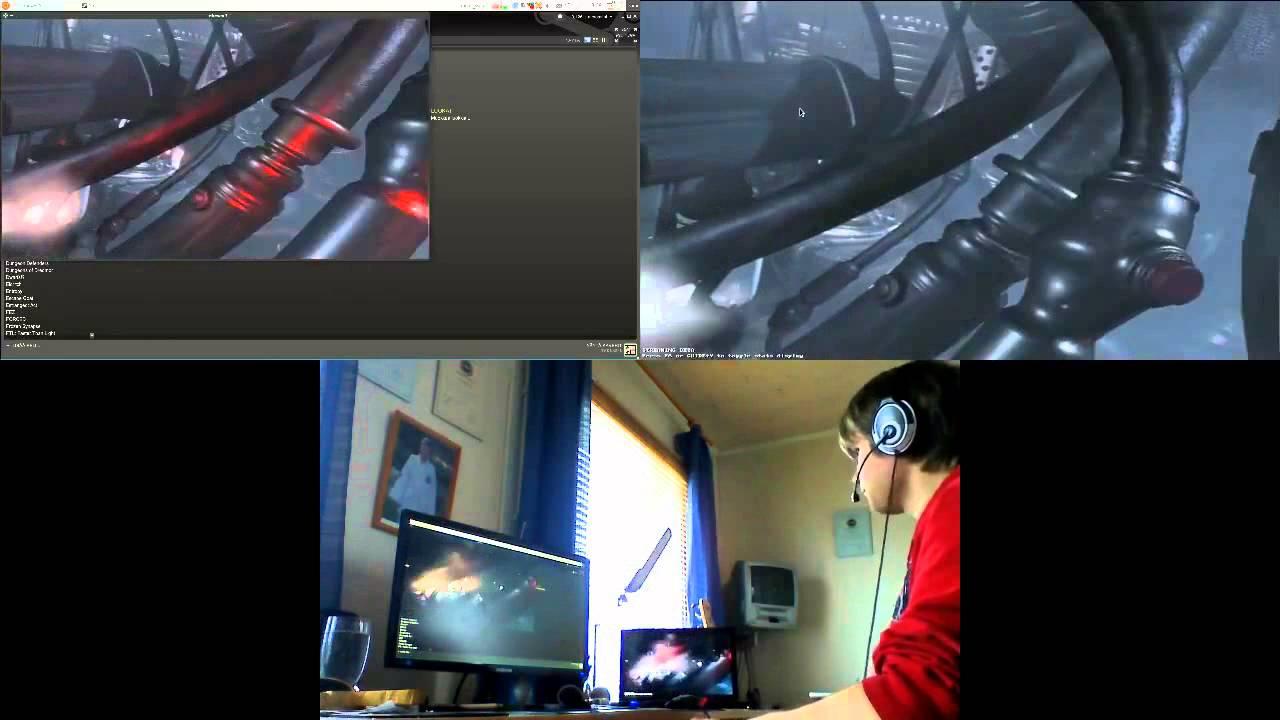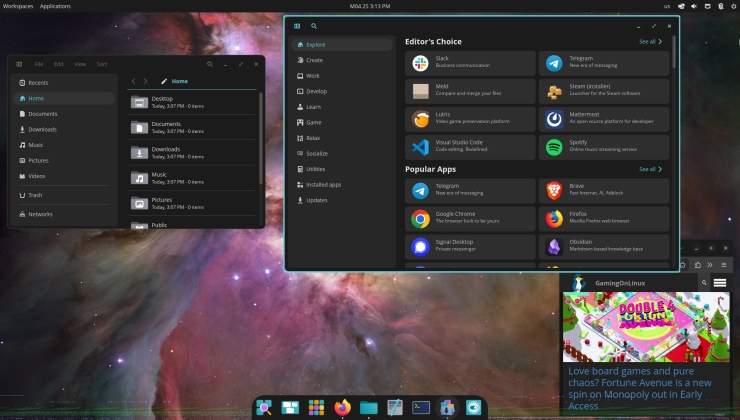In-Home Streaming was part of the SteamOS announcement Valve made back in September and beta invites to the functionality have been sent to some people around the internet. Luckily I was part of that group and I can share some of it with you!
Steam's In-Home Streaming basically means that you use one of your computers (the most powerful presumably) to basically “play” the game and stream that to your another device for actual playing. This allows you to use any computer that can run Steam to run almost any game that the more powerful computer is able to run. The games also don't have to be on Steam, with many games you can simply add a launcher into Steam and be able to stream that game through the streaming service too, for example Doom 3 running with the Dhewm3 engine, which I showed on the video. On Linux-side of things it also means that you can run games designed for Windows on Linux by letting your Windows machine run the game and stream it to your Linux computer. “Sadly” I don't have one of those Windows machines, so I will only be able to show you how it works from a Linux host to a Linux client.

As you can see, games tend to run pretty nicely through the In-Home Streaming even with the screen capturing software running and the latency is pretty much unnoticeable. What is also rather surprising is the fact that you can also stream from computers with lower specs, so you don't necessarily have to get the latest NVIDIA graphics card to use the In-Home Streaming. With an Intel HD Graphics 3000 and an i3 I was able to stream Portal with acceptable framerates to my main machine, though on the video it was capped at ~15 FPS due to SimpleScreenRecorder running in the background.
This is the thing that caught my interest most in the Valve announcements and I am happy to see how well it is working even in beta. Of course I still some bugs and mouse input with games on my laptop was pretty much broken, but I think the audio-video side, which is working fantastically, is the most difficult part of the process so we can probably expect the functionality to be there very quickly.
Will/would/do you use the Steam's In-Home Streaming functionality? Tell us in the comments below!
Steam's In-Home Streaming basically means that you use one of your computers (the most powerful presumably) to basically “play” the game and stream that to your another device for actual playing. This allows you to use any computer that can run Steam to run almost any game that the more powerful computer is able to run. The games also don't have to be on Steam, with many games you can simply add a launcher into Steam and be able to stream that game through the streaming service too, for example Doom 3 running with the Dhewm3 engine, which I showed on the video. On Linux-side of things it also means that you can run games designed for Windows on Linux by letting your Windows machine run the game and stream it to your Linux computer. “Sadly” I don't have one of those Windows machines, so I will only be able to show you how it works from a Linux host to a Linux client.

YouTube videos require cookies, you must accept their cookies to view. View cookie preferences.
Direct Link
Direct Link
As you can see, games tend to run pretty nicely through the In-Home Streaming even with the screen capturing software running and the latency is pretty much unnoticeable. What is also rather surprising is the fact that you can also stream from computers with lower specs, so you don't necessarily have to get the latest NVIDIA graphics card to use the In-Home Streaming. With an Intel HD Graphics 3000 and an i3 I was able to stream Portal with acceptable framerates to my main machine, though on the video it was capped at ~15 FPS due to SimpleScreenRecorder running in the background.
This is the thing that caught my interest most in the Valve announcements and I am happy to see how well it is working even in beta. Of course I still some bugs and mouse input with games on my laptop was pretty much broken, but I think the audio-video side, which is working fantastically, is the most difficult part of the process so we can probably expect the functionality to be there very quickly.
Will/would/do you use the Steam's In-Home Streaming functionality? Tell us in the comments below!
Some you may have missed, popular articles from the last month:
All posts need to follow our rules. For users logged in: please hit the Report Flag icon on any post that breaks the rules or contains illegal / harmful content. Guest readers can email us for any issues.
I had hit or miss functionality. I do not have any Windows boxes at the house. So I tried Linux to Linux and Wine (both 32-bit and 64-bit) to Linux.
Streaming from Linux did not always resize the resolution to match my laptop. Also, most games had some sort of issue. To The Moon was even upside down and mirrored.
From Wine to another Linux box always properly resized the resolution but there was no sound however there were no input issues as had been the case in Linux to Linux.
Streaming from Linux did not always resize the resolution to match my laptop. Also, most games had some sort of issue. To The Moon was even upside down and mirrored.
From Wine to another Linux box always properly resized the resolution but there was no sound however there were no input issues as had been the case in Linux to Linux.
0 Likes
I had hit or miss functionality. I do not have any Windows boxes at the house. So I tried Linux to Linux and Wine (both 32-bit and 64-bit) to Linux.
Streaming from Linux did not always resize the resolution to match my laptop. Also, most games had some sort of issue. To The Moon was even upside down and mirrored.
From Wine to another Linux box always properly resized the resolution but there was no sound however there were no input issues as had been the case in Linux to Linux.
I wouldn't personally consider that a "normal" use case, or the intended use at least.
Aside from that, WINE isn't written with streaming in mind (at least not yet).
0 Likes
I thought streaming from Linux wasn't working yet (in the FAQ: "Game launcher streaming from Linux is not currently supported."). Did I misunderstood or has it been implemented recently?
0 Likes
I thought streaming from Linux wasn't working yet (in the FAQ: "Game launcher streaming from Linux is not currently supported.";). Did I misunderstood or has it been implemented recently?It probably means that launchers like the settings launchers of Amnesia: The Dark Descent and Trine 2 etc don't work. The streaming from Linux works fine as you can see from the video. :D
0 Likes
biggest feature im looking for in steam, i dont mind running a windows box in a cupboard some where.. just refuse to use it as my main OS..
0 Likes
Nice video :) However, the recordings are not in sync, the client actually runs ahead of the server. This basically renders all latency comments unsubstantiated :]
Also, how is it doing with client input?
Probably won't use it for now as I don't have 2 rigs with a practical form factor at the moment.
Oh and all windows in the house lead to my neighborhood ;)
Also, how is it doing with client input?
Probably won't use it for now as I don't have 2 rigs with a practical form factor at the moment.
Oh and all windows in the house lead to my neighborhood ;)
0 Likes
Nice video :) However, the recordings are not in sync, the client actually runs ahead of the server. This basically renders all latency comments unsubstantiated :]Ah, I was actually supposed to mention this, but I forgot. Yes, the recordings are off-sync because I had to synchronize them manually and I can usually only get it somewhat right. It didn't help that the constant game changing usually messes up the recording, though this time it was mostly just the audio. That's why I decided to use the tablet to show both of the screens at the same time with lower quality to show what the latency between the client and the host is all about.
Also, how is it doing with client input?
Probably won't use it for now as I don't have 2 rigs with a practical form factor at the moment.
Oh and all windows in the house lead to my neighborhood ;)
The client input is pretty much there, though my laptop's touchpad seems to screw up the mouse input pretty badly. Keyboard works with almost every game I've tested and there isn't any noticeable latency to speak of.
0 Likes
Regarding video sync issues: I don't know how this would work in practice but makes a sense as a mental experiment...
Sync the clocks of both rigs to a high precision (NTP?). Run a cron job at the same time on both machines for a task that leaves a visual clue. Of course this task should not be resource-intensive (xev?) to eliminate differences in rig performance. The screen recording(s) should be started beforehand, obviously.
Sync the recordings in post-processing based on the visual clue.
Sync the clocks of both rigs to a high precision (NTP?). Run a cron job at the same time on both machines for a task that leaves a visual clue. Of course this task should not be resource-intensive (xev?) to eliminate differences in rig performance. The screen recording(s) should be started beforehand, obviously.
Sync the recordings in post-processing based on the visual clue.
0 Likes
I wouldn't personally consider that a "normal" use case, or the intended use at least.
Aside from that, WINE isn't written with streaming in mind (at least not yet).
According to the FAQ on the Steam Group page streaming from any Steam platform to any other is the eventual intended use. Though I doubt that Wine to Linux will be officially supported.
0 Likes
I'm actually rather interested in this. Now I know what I'll do with my current computer :)
0 Likes
I've done some testing two or three days ago and was impressed how easy was to get it running. Performance was nice, very playable, even with my very old laptop on the steam streaming guest side (how do you call it, stream destination?). Here some data:
Steam "Server" (source):
Steam "Client" (destination of the stream):
I just tried following games and both tests were successful:
With Portal on my laptop I have most of the time about 30 fps, sometimes down to 20 fps. Input latency was good, not much lagging. I'm quite impressed, this laptop was really no game machine at all, until now. :-)
I'll do some more tests later this week.
Steam "Server" (source):
- Athlon64 X3 Phenom II
- Radeon HD5850 with open source driver r600g
- Gentoo Linux, kernel 3.13.0, Mesa 10.0.2
- 1 Gbps ethernet
Steam "Client" (destination of the stream):
- Old Acer Laptop
- Intel Centrino Single Core CPU
- Radeon Mobility X200 with open source driver r200 if I remember well
- Linux Mint 15
- 100 Mbps ethernet
I just tried following games and both tests were successful:
- Portal
- A virus named Tom
With Portal on my laptop I have most of the time about 30 fps, sometimes down to 20 fps. Input latency was good, not much lagging. I'm quite impressed, this laptop was really no game machine at all, until now. :-)
I'll do some more tests later this week.
0 Likes
I was also picked in this round of betas, however I have not got it working yet.
My 2 steam computers don't see each other, they do not show up in the In-Home Streaming/Devices list.
I'm not sure why, but it might be because I'm using official ip addresses, not rfc1918 (local network).
Anyone else have this problem?
My 2 steam computers don't see each other, they do not show up in the In-Home Streaming/Devices list.
I'm not sure why, but it might be because I'm using official ip addresses, not rfc1918 (local network).
Anyone else have this problem?
0 Likes
The above connection issue was caused by some iptables rules set up by libvirt/kvm...
Now, however, my problem is that no input (keyboar or mouse) seems to be forwarded to the "server/host" from the "client". o_O
Now, however, my problem is that no input (keyboar or mouse) seems to be forwarded to the "server/host" from the "client". o_O
0 Likes
I've setup a system with LTSP and virtualgl that works pretty well. Virtualgl will also run wine and integrates with turbovnc/tigervnc as well. Virtualgl doesn't do sound, but that's handled in ltsp with pulseaudio anyway. So now any pc that can boot from lan, runs linux without needing to install anything including 3d games. Off course you don't need LTSP, virtualgl will work on just about any linux and you'll only need enable networksound for pulseaudio to complete the experience.
0 Likes









 How to set, change and reset your SteamOS / Steam Deck desktop sudo password
How to set, change and reset your SteamOS / Steam Deck desktop sudo password How to set up Decky Loader on Steam Deck / SteamOS for easy plugins
How to set up Decky Loader on Steam Deck / SteamOS for easy plugins
See more from me